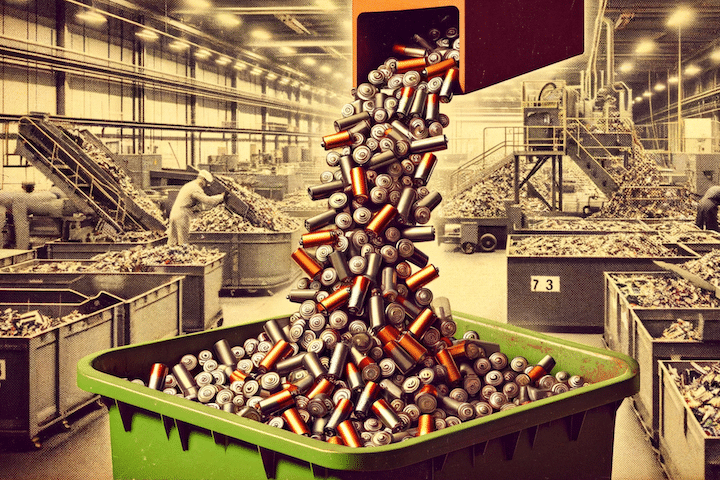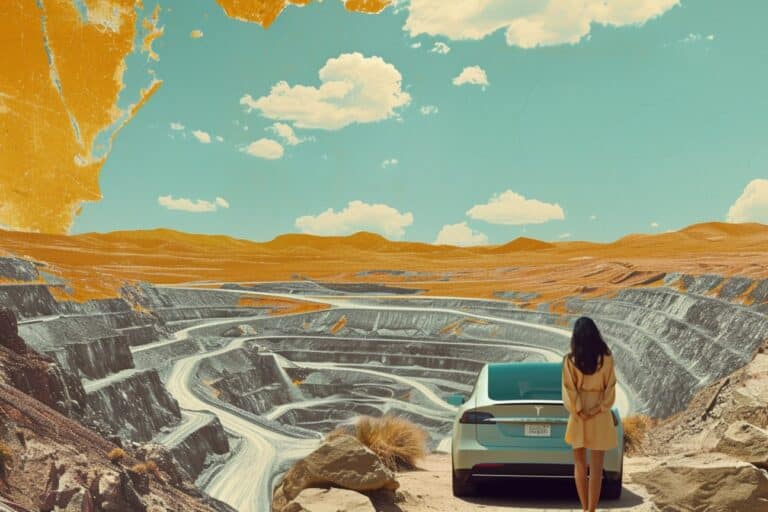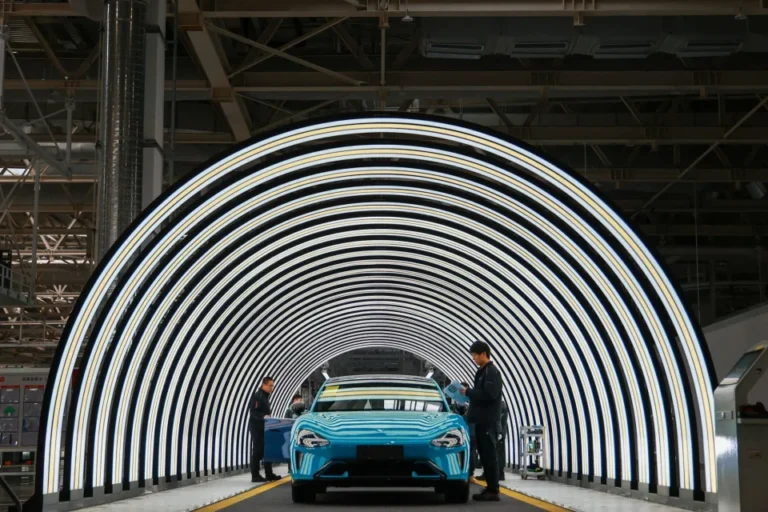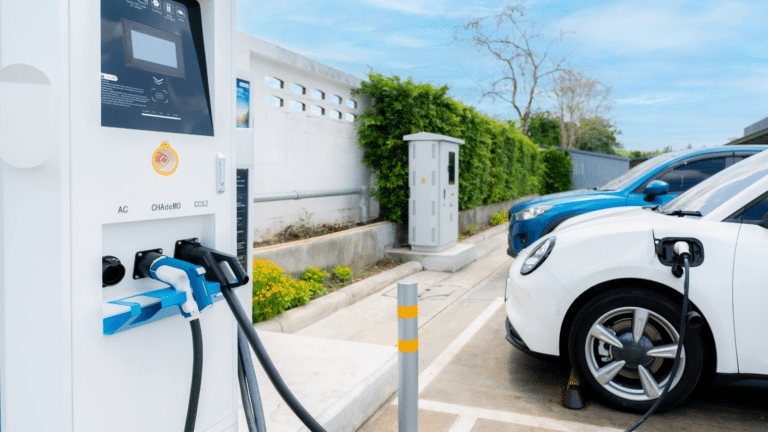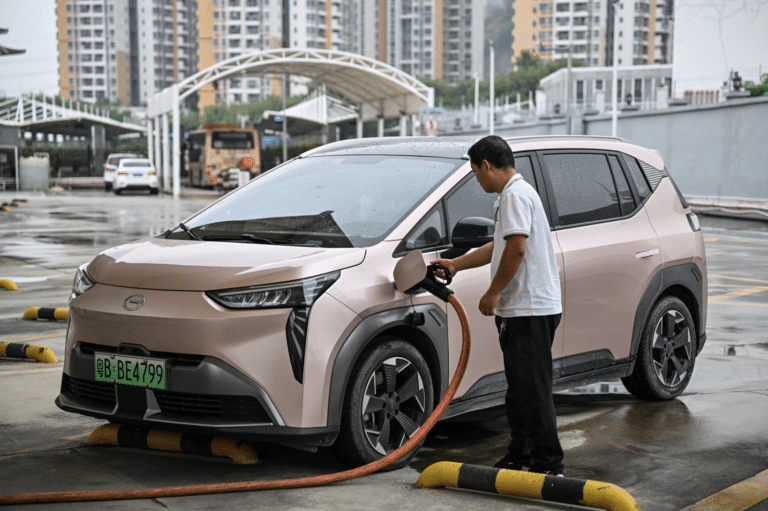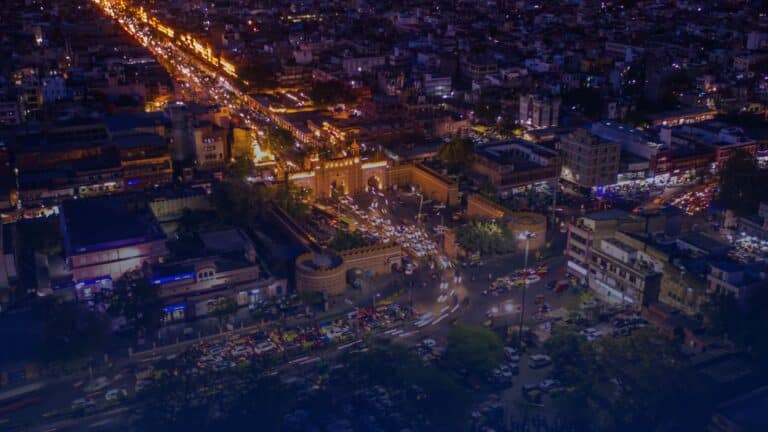Melissa Lott: [00:00:00] There are a lot of things that could go wrong with EV charging stations. You know what I’m talking about. It’s those things that you plug your electric car into. [00:00:07][7.1]
Yvette Ellis: [00:00:11] We have found frogs in the charging stations, right? [00:00:15][3.9]
Melissa Lott: [00:00:15] From like. [00:00:16][0.8]
Yvette Ellis: [00:00:16] Frogs like ribbit. Wow. Yes. [00:00:19][2.8]
Camille Terry: [00:00:20] You can have an infestation of spiders. You can have a rat inside the station. I don’t know how they get in. These are real things. We’ve had a bunch of ants in one. We’ve had technicians fight off yellow jackets in Georgia. [00:00:38][17.8]
Melissa Lott: [00:00:39] Most of the time when Chargers quit working, it’s actually the software that’s causing the problems. But these assaults by Mother Nature. You just can’t make this stuff up. [00:00:47][7.9]
Camille Terry: [00:00:47] We’ve had full blown beehive nests to where the honey from the nest was oozing out of the charging station. [00:00:56][8.5]
Melissa Lott: [00:00:59] But no matter the reason, there are a lot of broken down TV charters across the U.S. And as we work to make sure that we can switch away from gas guzzling vehicles as quickly as possible in order to help fight climate change. Well, these broken chargers, they’re a huge problem. [00:01:14][14.4]
Yvette Ellis: [00:01:16] The charging stations cannot be down. It’s just a no no. It’s like imagine going to a gas station every now and then. You may see one pump not working, but imagine going to a gas station. None of the gas pumps are working on all four corners. Can you imagine? It just doesn’t even seem real to us. [00:01:34][18.2]
Melissa Lott: [00:01:35] A study this march from the nonprofit called Cool the Earth found that a quarter of EV chargers in the San Francisco Bay Area were broken. And according to The New York Times, one charging company called Chargepoint said that only 61% of its chargers were actually successfully charging. And let’s talk about why this is a really big deal, the highest level. It’s because EV sales are finally taking off. We’ve got companies like GM who are saying they’re not going to make any more gas powered cars by 2035. And we even have entire states like California who are banning new gas and diesel car sales starting in 2035. So if we look at the around 25%, a quarter of all emissions that are coming from the U.S. each year, they’re coming from transportation. And if we want to bring that number down, we have to have a reliable network of EV chargers in place to charge our electric vehicles. In this episode, we’re going to talk through two big questions. First, how do we fix all these EV chargers? And second, who’s going to do it? [00:02:35][59.9]
Yvette Ellis: [00:02:36] We knew that there was a population of workers out here that were curious, that were willing to do this work. This is not an engineer’s work. This is not someone that wants to sit behind a screen. You need people with grit. [00:02:52][16.3]
Melissa Lott: [00:02:53] And you need a lot of these people. I’m talking about a small army of these EV charging station technicians. And as it turns out, there’s this company in L.A. that’s tackling the EV charger problem in this pretty unique way. They found a way to solve a climate problem while also solving an equity problem. [00:03:11][18.3]
Yvette Ellis: [00:03:12] We’re changing how we do transportation, but this is going to be a wealth push for lots of communities, for lots of folks. The opportunity for businesses to be started like this really is a once in a lifetime opportunity for our country. [00:03:25][12.7]
Melissa Lott: [00:03:26] This is the big switch. A show about how to rebuild the energy systems that are all around us. I’m Dr. Melissa Lott and I’m the director of research at Columbia University’s Cyber Center on Global Energy Policy. [00:03:36][9.8]
Yvette Ellis: [00:03:36] And. [00:03:36][0.0]
Speaker 4: [00:03:43] And part of the infrastructure while we’re investing $7.5 billion to build electric vehicle charging stations all across America. [00:03:50][7.9]
Melissa Lott: [00:03:51] This is President Biden and he’s speaking in Detroit this September. He’s talking about the funding that the federal government will be spending to build EV charging stations across the United States. [00:04:01][9.7]
Speaker 4: [00:04:02] So today, I’m pleased to announce where appropriate funding for the first 35 states, including Michigan, to build their own electric charging infrastructure throughout their state. [00:04:13][10.9]
President Biden: [00:04:18] And you all are going to be part part of a network of 500,000 charging stations. 500,000 throughout the country. [00:04:30][11.9]
Melissa Lott: [00:04:31] Half a million charging stations. Sounds great. And if we’re going to switch from polluting gas cars to EVs, then we’re going to need those stations and probably millions more. But we also need those charging stations to work. But the Chargers keep on breaking. And you would think that there’d be plenty of technicians around to repair those highly in-demand chargers. But charging companies and car companies have largely been ignoring this problem, which honestly, I can understand to some degree. I mean, there’s been this massive demand for electric vehicles. So companies have been focused on building the cars and getting charging stations installed. There hasn’t been a lot of focus on maintaining and repairing those charging stations, at least not yet. [00:05:10][38.9]
Yvette Ellis: [00:05:11] The goal everything was installation, so training, operation and maintenance had not become essential yet. [00:05:17][6.5]
Melissa Lott: [00:05:18] This is Yvette Ellis. She’s not an EV charging station technician, but she has a unique skill set. It’s a background that you just might not associate with charging stations. But as it turns out, it’s just the right thing for the job. [00:05:31][13.5]
Yvette Ellis: [00:05:32] Amy Ellis I grew up in Compton, California. I say that with great pride. My very first job was I went to the Compton Summer Job program to get a summer job, either at the pool or the park, wherever they had. And I got there, and as I waited in line, I saw this lady behind the counter and she was doing everything. She had a clipboard and you could tell in my 13 year old hair she was powerful. [00:05:58][25.8]
Melissa Lott: [00:05:59] Yvette explains that workforce development is something more than just training people. It’s about better jobs, better pay and better lives. [00:06:07][7.2]
Yvette Ellis: [00:06:07] Well, first, workforce development is a development for me. This embed ology. Okay, you might not find this on Google. It’s a development of work, right? Like I always tell people, if there’s not a job or an increase in income at the end of your workforce development effort and it wasn’t workforce development. [00:06:25][17.5]
Melissa Lott: [00:06:26] Yvette spent eight years at the Long Beach Job Corps Center. It’s this federal workforce development program in the L.A. area. And in 2019, she was working as a career coach at this organization called the Los Angeles Clean Tech Incubator, or Lacey. It’s a nonprofit that helps startups in clean tech. I’m talking about solar and wind batteries. All of those technologies that we love to talk about on this show. But here’s the thing. Clean tech is generally a pretty white and pretty male dominated area. And as a working class black woman from Compton, Yvette was new to the space. [00:06:58][32.8]
Yvette Ellis: [00:06:59] When I was introduced to it. You know, because clean tech has not always been the most diverse place. It was a place that was unfamiliar to me. Like, I thought like, Hey, I need to be a scientist. Are some techie person to be a part of this. But really, what Lacey is, is an incubator for clean tech companies to grow for startup. [00:07:22][22.6]
Melissa Lott: [00:07:23] And it was at Lacey that Yvette met another black woman named Camille Terry, who worked at an EV charging station, software company. And in her work, helping clients set up stations. Camille kept running into this problem of broken chargers. The auto companies and the charging companies were rushing to install as many stations as possible, but they didn’t have the workforce to maintain them. [00:07:43][20.9]
Yvette Ellis: [00:07:44] What surprised me was that our industry, as much as we needed it, still needed some time to like make operations and maintenance, like, really important. Mm hmm. Now, 22. Yes, we see it now and it’s all good. But it was surprising to see that this was a huge problem, but it wasn’t the most important thing on the agenda. [00:08:08][24.2]
Melissa Lott: [00:08:10] These companies would fly the very few technicians that they had out into the field, but it was expensive and it wasn’t enough to solve the problem. So Camille saw an opportunity to build an entire team of technicians that were based all over the country and could fix the charging stations in their local areas. But she needed help from someone who could actually find and train all the technicians that they would need. [00:08:30][20.3]
Yvette Ellis: [00:08:31] We were both contracted as contract this far lazy. I was a career coach. It was extra money for me. They had a workforce development program, a technical training program. And Camille was contracted in as the technical trainer, which she developed the curriculum around how to fix broken TV charging stations. I thought she was brilliant just to know about the issues from clean tech. She spoke the language. I’m like, You go, girl. How can I support you, girl? And she said, You know, would you be interested in being my my co-founder? I was like, I don’t want to be a co-founder. Don’t actually know what a co-founder does, because I come from a working family. You know, we do 9 hours, we get our paychecks on Friday. You know, we keep our head above water. So after talking to my husband, I said, okay, I’ll do it for a year. And if it takes off, then great. And if it’s not, If it does not, then I want out. [00:09:31][60.4]
Melissa Lott: [00:09:32] Fortunately, a vet and Camille stuck together and a vet became the chief workforce development officer at this company called Charger Help, and Camille became the CEO and their vision was to hire and train local technicians in every state to repair charging stations across the country. [00:09:47][15.4]
Yvette Ellis: [00:09:48] Kind of like the Geek Squad. You know, they’re they know all things charging stations. [00:09:53][5.3]
Melissa Lott: [00:09:54] So in 2020, a vet and Camille were learning about the problem and raising money, but they didn’t have any technicians yet. And they figured out that the technicians they would need to hire could come from a wide variety of backgrounds. Yes, you need to be an electrician to install an EV charging station, but not to repair one. Can you help me picture what, like some of the very first conversations around this look like for you? [00:10:18][23.8]
Yvette Ellis: [00:10:18] So we kind of created an ideal candidate profile and we just you know, when you’re building a company, you get to dream out whatever you want to dream out. And so we thought, like, who are our ideal people with maybe some of the soft and hard skill sets? That would be very interesting. And we found that the folks that that were most interested when we, you know, push this out to work for us development centers and just unusual places. We found the folks that responded. Most were people that came from gas and oil, from refineries. Mm hmm. Those folks are so safety heavy. And we needed that. Right. We needed to bring the safety part of it into our industry in this position in particular. So folks from gas and oil, folks from closing factories, they knew how to work machinery, little parts, and they were very detail oriented and understood doing the same thing over and over and looking for the same problem over and over. And then lastly, I would say folks that came from cable and Internet that, you know, they weren’t an electrician, but they’ve been in folks houses. They understand what it is to get something up and working and to deliver right. A working product by the end of their shift or their work order. And then lastly, feel service folks that have know what it is to be out driving all day, moving around in traffic, moving around in new cities, and really have the deliverable of making sure something works by the end of their shift. Those folks became essential. Mm hmm. Right. And really what they have is willingness to get it done. [00:11:56][97.9]
Melissa Lott: [00:11:57] And this is where Yvette and Camille did something another tech company might not think to do. They saw an opportunity to solve the second big problem. Climate tech is big business, and fighting the climate crisis may be the biggest business opportunity in the history of humanity. But those jobs, those benefits have largely gone to wealthy white males. And Camille and invest saw an opportunity to solve an emissions and technology problem at the same time that they solved an equity problem. So they went out looking for candidates at workforce development centers, community colleges and a lot of other places. And they went looking for cable field techs, oil and gas workers and others who had grit, you know, the grit to handle frogs and bees and finicky software and broken charters. [00:12:43][46.5]
Yvette Ellis: [00:12:44] So those were the ideal candidate soft skills that we were looking for, people that had been familiar with that space. And when you look at who those people are. A lot of them were black and brown people like. [00:12:56][11.9]
Melissa Lott: [00:12:57] Women and lower income folks. Black and brown people have often been left behind in the wealth building opportunities of clean tech. Which brings us to the second voice in our story, Vanden Staley. Last year, Charger Howe hired Vanden as one of their first technicians. Like a vet, Banham is from Southern California and also like a vet who grew up in a black working class family. Before Charger Help, he had had a really broad array of jobs. [00:13:22][25.0]
Camille Terry: [00:13:23] All of my jobs have a common common denominator, which is customer service. I love helping people just naturally love helping people. So my very first job was Wal-Mart in soft lines is clothing, right? [00:13:40][17.0]
Melissa Lott: [00:13:40] Vendors worked at Wal Mart, Home Depot as a construction laborer, a welder, a P.E. instructor, a field technician from a cable company, and as technical support for a payroll company. But then he heard about charger help from some friends. [00:13:53][12.5]
Camille Terry: [00:13:54] And I was like, I’m going to try it out. So I took the leap of faith, applied. I put together my field technician experience with the cable company and my training experience at the payroll company, but basically saying like, I can start out as a technician, but then eventually, like if you need me to do any trainings, I’m, you know, I can do that as well. So they saw that. They fell in love with it and got hired on and then started my career with. [00:14:25][31.4]
Melissa Lott: [00:14:27] So let’s talk about what these technicians actually do. First, some background on the stations themselves. So there are three levels. Level one is literally just plugging an electric vehicle into a wall outlet. It’s kind of slow. It can take upwards of 20 hours to reach a full charge on the battery level. Two is faster. It takes 5 hours to charge a 100 mile battery, according to charging company CHARGEPOINT. But the fastest are level threes. President Biden wants to install 500,000 of these across the U.S.. And these are the ones that charger help spends most of his time on. [00:15:01][34.3]
Camille Terry: [00:15:02] Those are your DC fast chargers. Those are the ones where, you know, it’ll take 30 minutes to give you a full battery charge from 0% to like 80%. Those are the ones they the industry call A refers to them as the refrigerators because they’re about as tall as a refrigerator and maybe even taller. About the same with very noticeable because a lot of companies like to use LED lights to grab your attention. [00:15:29][26.9]
Melissa Lott: [00:15:30] They’re also quite a bit more complicated than a wall plug. You can kind of think of them like smartphones. Here’s a vet. [00:15:36][6.1]
Yvette Ellis: [00:15:37] I think of a charging station as a cell phone. You have your software providers who are like your overrides into your sprint, your T-Mobile’s who provide the actual service. And then you have the manufacturers, which is like your Apple or your Samsung that provides the actual hardware. So we work with both whoever is in charge of the help and maintenance operations and maintenance of the charging station. [00:15:58][21.2]
Melissa Lott: [00:15:59] So in the case of charging stations, you have manufacturers that make them and then you have software providers also known as network providers that run the software for them over the Internet. And things can go wrong with both the hardware and the software. And this brings us to another reason stations don’t get fixed quickly. They’re just kind of finicky Diagnosing what’s wrong with the charging station can be a mystery at first. And it takes a lot of coordinating with manufacturers and software providers to figure out what on earth is going on, which is why Charger help gives their techs a lot of different tools. [00:16:33][34.3]
Camille Terry: [00:16:34] We provide PDFs, even sometimes videos on exactly what you’re going to do step by step. We also have the support of either the manufacturer or the network provider whose software or hardware is inside of the charging station. But you have a number for them. So we’ll get out there and we’ll call them and say, Hey, I’m here to service the station. Is there anything in particular you need me to do to troubleshoot? And they will also walk you through. Okay, you did everything on the PDF that didn’t work. Okay, so try this, unplug this and loosen this and put it back. Take this out. Put it back. So it’s. It’s really you just being the eyes and ears and the hands of them, because they can’t physically be there because a charging station could be in Houston, Texas, but the manufacturer is in Atlanta or the network provider is based out of New York. So besides in flying somebody out, they send us because we’re local and we’ll go and do everything for them. [00:17:40][65.4]
Melissa Lott: [00:17:42] And sometimes that process is fast, but sometimes it takes a whole day to find this little random part that happened to be broken. [00:17:49][7.2]
Camille Terry: [00:17:50] So you can do you can do like maybe three locations. If they’re fairly in the same area, you can do three locations you can do up to. I mean, I think we’ve had a technician do like 12 to 15 charging stations in a day. Rock star. But then also you can go and do one charging station and they can take you a whole day because of it being just complex and just getting to that one piece are one part. You have to take apart a bunch of things. [00:18:22][31.9]
Melissa Lott: [00:18:22] It can be a slog sometimes, but for Vanden, the best part of the job is when the EV drivers see him pull up. [00:18:28][5.6]
Camille Terry: [00:18:29] You’re a superhero. When you pull up to the side, you pull up and you’re there like you’re going to fix the charging station. Guess right this way. You want some water, then you can get you like it’s it’s you’re really invited to fix it because again, it only affects the people who need it, right? So other people are like, Oh, you’re here or whatever, but the people who use it, they’re like, Oh my goodness, thank you. You could be working on a charging station in at least three or four people will come up to you and thank you for doing it. And then they may, you know, have a small talk. What was wrong with that or anything? But for the most part, you pull up to a site and you’re just welcome because you’re there to give a solution. And it’s the best feeling in the world. [00:19:14][44.7]
Melissa Lott: [00:19:16] For a vet. One of the best things about her job is learning about the people she’s empowering with her work. [00:19:21][5.7]
Yvette Ellis: [00:19:22] I would say what sticks out in my head most even. More than like, yes, the money is here was to see the real people that we’re impacting. When I have a technician tell me like, Hey, I’m going to send a verification of income over because my wife and I are applying for a house based on which charge or help pays. You know, we we started our takes off with $30 an hour which is good money but if people I make like way more than 30 on an hour but that was enough for that particular family to apply for a house or a technician and say like, yes, me and my wife finally got the right insurance and we can do IVF, you know, because we were very particular in the type of insurance that we wanted them to have access to our LGBTQ plus community that wanted certain therapies and options in their in their health care plan was a big deal. Right. And to make sure that we had health care options for them, that that could feed into that is so much more than fixing charging stations is really changing these folks lives and giving them power and and room to dream again. [00:20:29][66.6]
Melissa Lott: [00:20:30] Earlier this year, Congress passed the Inflation Reduction Act, which included hundreds of billions for EVs and other climate tech. So who benefits from all those investments? When we look at the Inflation Reduction Act that just passed in the US, I mean, it’s a massive infrastructure bill in the heart of it, right? It’s going to channel billions of dollars into electric vehicles, both directly and indirectly. And also there are all these other kinds of climate technologies and thinking about that wealth building opportunity, the need for workers, workforce development, the work that you do, how do we channel these benefits in this equitable way? And are there any lessons that you have learned from your work that you could share with us so we can see how this could actually work in reality? [00:21:14][44.4]
Yvette Ellis: [00:21:15] So there are billions of dollars being deployed in EV charging, not even like manufacturing of cards and all that jazz charging 7.5 billion or close to that just in charging. So. I think this, as I said before, the opportunity for us to allow other folks on the field to compete for jobs, to compete for entrepreneurship opportunities, contracts, bids, all that jazz. I think that’s the biggest opportunity that lays here the gap in training, education and wealth in our country. It will take years to close the gap and it will take collaboration and cooperation from lots of folks. So I don’t get lost in that sort of I don’t know where we are with that, but I do think we have to create a standard, you know, of what is acceptable in our country. It cannot be folks and companies becoming uber successful and rich and they are not diverse and inclusive like that should become a no no in our country. [00:22:23][68.0]
Melissa Lott: [00:22:24] And this is a lesson for other organizations that are working to solve climate problems. [00:22:28][4.3]
Yvette Ellis: [00:22:29] Yeah, the equity piece is huge, but not just in like where you’re putting in charging stations, but who gets the jobs, who gets access, who’s designing the car, who’s designing the charging stations? Does it work for every community? Because if the lens of the person that’s creating everything, if that’s not a diverse team, right, then you’re not going to get a product that works for our very diverse country. [00:22:53][24.0]
Melissa Lott: [00:22:54] And she has simple suggestions for how to build a diverse and inclusive team. [00:22:58][3.6]
Yvette Ellis: [00:22:58] And you know, in these the simpler things, Melissa, that, you know, I don’t even know if I should say this, but if you look at your team and your team is all one of anything, you got a problem and you don’t even need a specialist to come in and tell you, right. Like you got a problem. Whether you’re doing it on purpose or you’re not doing on purpose, you have a problem. And so you have to go back to the top. Who is accountability for your h.r. Folks and the folks that are training and recruiting. Is it time for us to look at new recruitment measures? Is it time to look at your pipeline? Who do you deal with? Is it time for your h.r. Folks to go back and say like, hey, some of these job descriptions and requirements have barriers built in that historically leave people out. [00:23:43][44.9]
Melissa Lott: [00:23:44] Yvette abandons team is working on building a diverse workforce. Vanden got promoted from technician to trainer, which means he’s helping to bring others into the field. [00:23:53][8.8]
Camille Terry: [00:23:54] So some of those conversations will include just being like you said, is basically our front. Like this industry is is ran by predominantly white male. And so already we are catching up in a sense, right? So just being able to introduce them to the industry period is the big blessing that I think it is. Right. [00:24:21][27.1]
Melissa Lott: [00:24:22] They’re aiming for a big team. So how many technicians are we talking about here? [00:24:26][4.9]
Yvette Ellis: [00:24:27] So we started off with 20 technicians. By the end of 2022 we will be in all 50 states. So upwards of 100 technicians. I do know this for the 500,000 charging stations that I know the White House has mentioned right there in the graph, you will need at least 1100 technicians to even maintain that. And that’s just 500,000. We are know, 500,000 will not electrify our entire country. Tip of the iceberg, Correct. So this workforce is necessary. [00:25:01][34.1]
Melissa Lott: [00:25:07] And that’s our show. Next time on the Big Switch, How to Transition fossil fuel Workers to jobs in a net zero Economy. The big switch is produced by Columbia University’s Center on Global Energy Policy in partnership with Postscript Media. This episode was produced by Daniel Waldorf in Alexandria. Her story editing by Ann Bailey, Mixing and Scoring by Sean Marquand and Greg Bill Frank Theme Song by Sean Marquand. And a special thanks to our Columbia team, Kirsten Smith, Kewley, Liz Smith, and Natalie Volk. Our managing producer is Cecily Martha martinez and our executive editor is Steven Lacy. I’m Dr. Melissa Lott. And this is the big switch. [00:25:07][0.0]
[1430.1]



